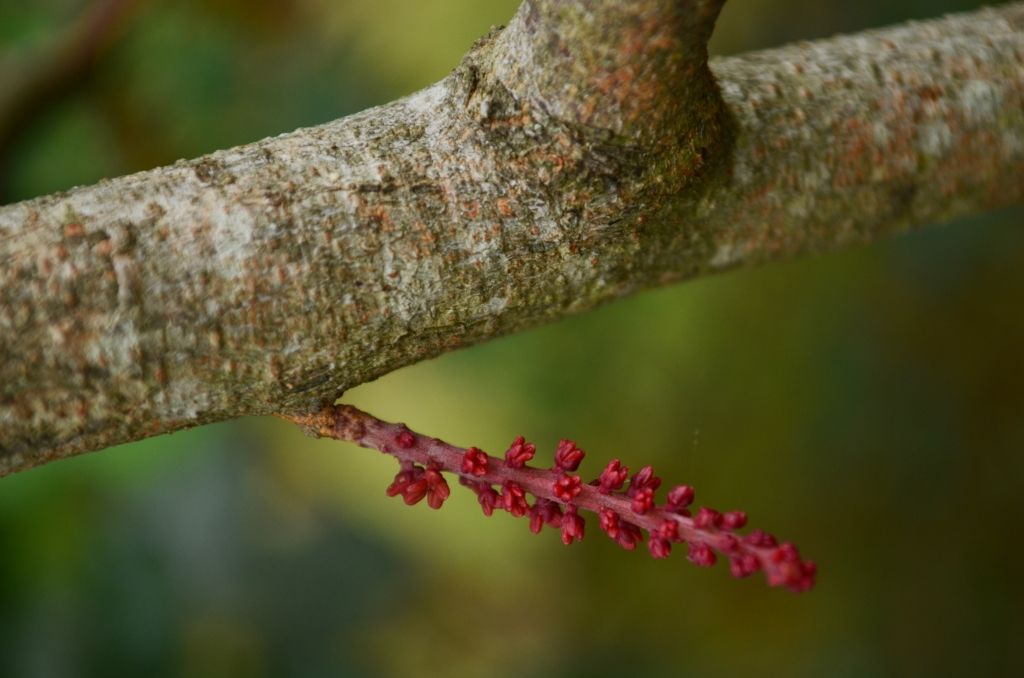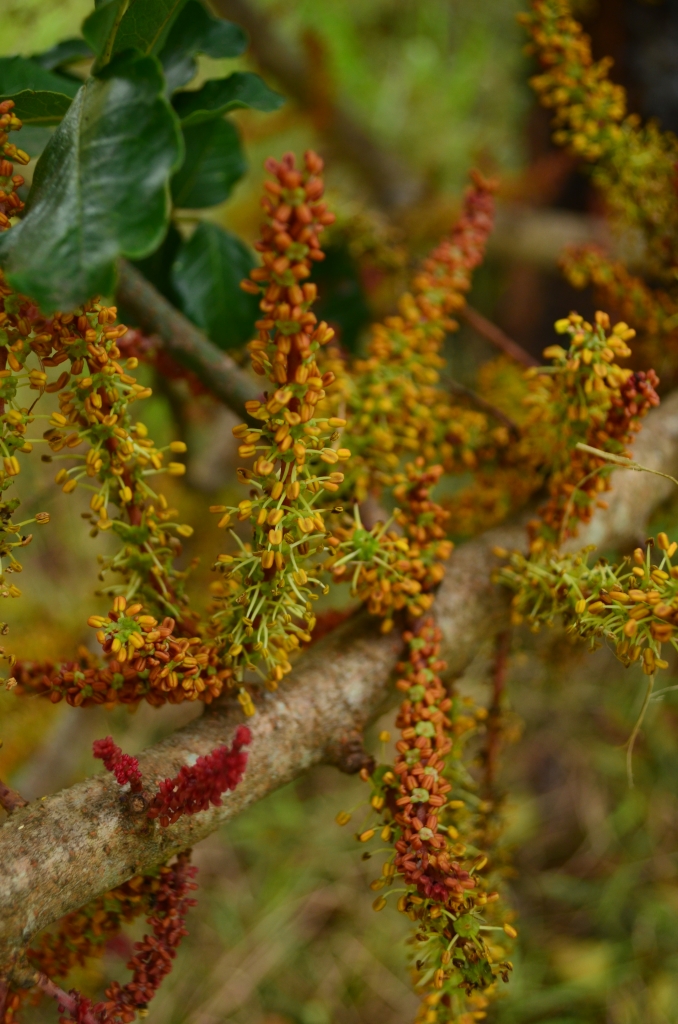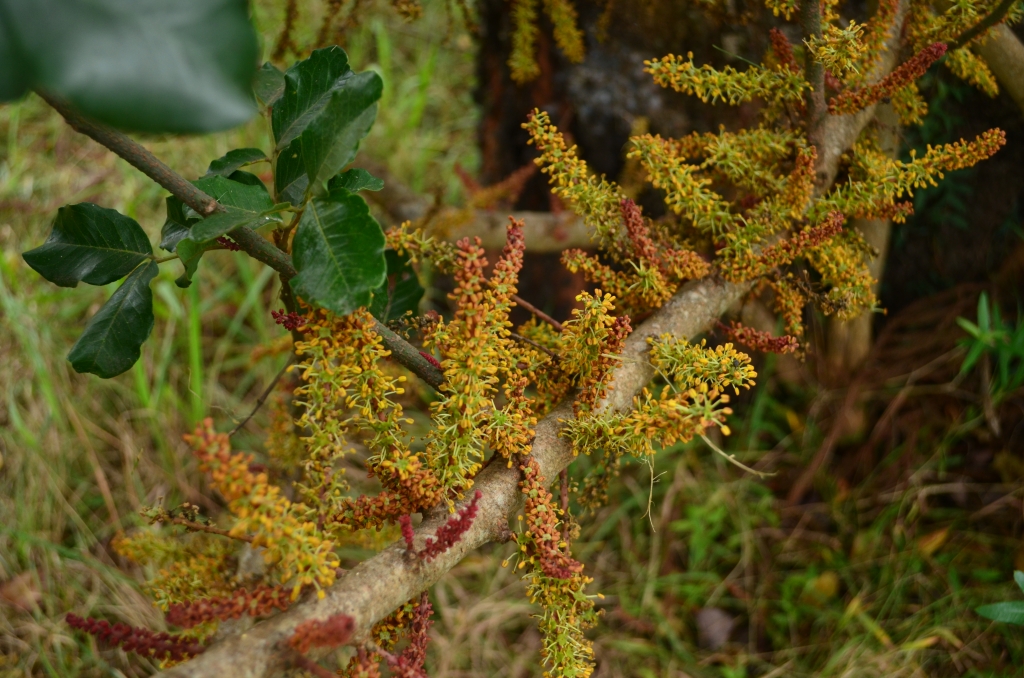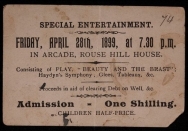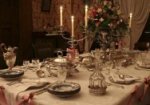For the past fortnight one of the garden trees at Rouse Hill has been putting on quite a show, but you need to know where to look!
Down at the eastern end of the garden at Rouse Hill, just by the summerhouse, one of the ornamental trees has been flowering for several weeks. But if you didn’t know they were there you’d completely miss its intriguing and delicate flowers: this week we’re having a look at the carob tree.
Carobs are drought and salt resistant with deep roots and in ideal conditions can grow to about 15 meters high with a nicely rounded habit. The tree seen at Rouse Hill today is largely a series of suckers growing from the base, where the old central trunk has died back with age (it was likely planted while 3rd generation Edwin Stephen and Bessie Rouse were in residence) . It gives it an uncharacteristically lop-sided appearance as a result. The carob is a member of the legume family – which includes the peas and beans – and so is useful in fixing nitrogen in the soil, and can bear both male and female flowers.
To botanist Charles Fraser, who compiled a “Catalogue of plants cultivated in the Botanic Garden, Sydney” in January, 1828, the tree was scientifically known as Ceratonia siliqua, or colloquially as the ‘Locust’, ‘St. John’s Bread’, ‘Algarroba bean’ or the familiar ‘carob’. The first two names are interesting as one school of thought says this is what the Biblical account of St John surviving on “honey and locusts” actually refers to – the edible carob beans, and not voracious grasshoppers. Ideally suited to Sydney’s ‘Mediterranean’ climate, by the 1840s it was available to private gardeners from William Macarthur’s Camden Park nursery and soon after from Thomas Shepherd’s Darling Nursery. It was largely treated as an ornamental, though in its native environment around the Mediterranean it was known as a food for livestock – especially when other foods were scarce, and it was this purpose that attracted the attention of ‘economic improvers’ in the mid 19th century. It may have first come to the attention of the British during the Peninsula Wars (1807–1814) as there are some reports that the beans were used as horse-fodder in Spain.
Scientific illustration of the Ceratonia siliqua, from The natural history of plants, 1871-88. Image courtesy the Biodiversity Heritage Library, Cornell University
30 years after Fraser compiled his list, the Sydney Morning Herald wrote amiably of the very same specimen that it was believed had been planted in the very earliest years of the colony:
In the Botanical Gardens no record has been kept of the ages of the trees, nor of the time at which they begin to bear fruit. There exists… among the more ancient horticultural authorities a sort of legendary surmise that the Carob [in the garden] is an old colonist, and was one of the first to dispossess the original occupants of the soil when the upper garden was parcelled out some eight-and-twenty years ago; that he began to be prolific at eight or ten years of age, and has ceased to increase in size since he got well into his teens. He is likewise asserted to be extremely regular in his habits, and exact in his annual contribution to the state. Blow high or low, wet or dry, he ‘comes down’ with the beans, and the anticipated amount is invariably found to be ‘all there!’ Such is the capacity, and such the magnanimous disposition reported of the Carob. Coming among us with so beneficent a character, can we do better than cultivate his acquaintance?
A useful stock food
The article also wrote of the use of the bean’s use as animal food, and of the huge quantities exported around the Mediterranean for use as stock and horse feed.
This plant seems in so many particulars peculiarly adapted to our climate and circumstances, that I can hardly do better than bring it under the notice of those who can afford to give it a trial, well knowing that there are many among us who deem it a worthy and grateful employment to give back to the land that has enriched them something better than a Bathurst burr….
Their effect in fattening stock is said to be extraordinary, as might be presumed, from the extremely saccharine nature of the fruit, which is said to frequently occasion surfeit when given unmixed with less nutritious forage. It is, however, its simplicity of culture, its adaptation to a dry climate, and the little cost of harvesting and storing this bean which seem to me to point it out as peculiarly worthy of adoption by ourselves-especially in the dryer ports of the colony ; and since the fruit ripens here between August and October, it exactly hits the time when such districts are most liable to dearth.
The Sydney Morning Herald, Tuesday 20 July, 1858
Flower hunting
The flowers grow directly from the branches, so at a glance you’d never notice them. Alerted by our colleague Tony Boland, this week our acting head gardener Anita Rayner (you last saw her peering out from under a massive bunya cone) and I went flower-viewing (how genteel!). Climbing in between the branches the flowers revealed themselves: short, cinnabar red stems, either solitary or in clusters, are the male flowers, while the longer yellowy stems are the female flowers. To confuse matters some flowers are hermaphroditic. The flowers grow directly from the branches, not out amongst the leaves, which is the reason they’re largely invisible as you walk past. The long pods, which start bright green, take some months to fully form.
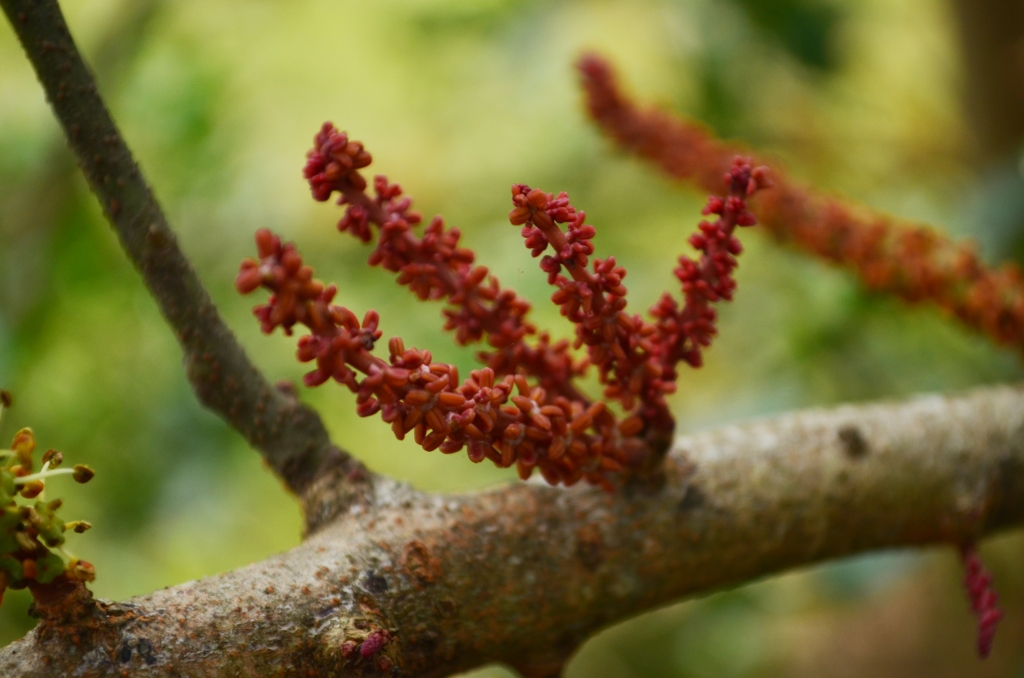
Cluster of red male carob tree flowers at Rouse Hill House. Photo Scott Hill © Sydney Living Museums
And the “I cant believe its not chocolate” carob?
While the carob bean has various uses, most people in Australia reading this will know of carob as a ‘chocolate substitute’. To make this, the dried bean casing – which can be up to 30cms long – is ground to a sweet powder (meaning you don’t need to add sugar) which can be used like cocoa powder in a drink or tuned into a confection, just as it has been for thousands of years. From the bean itself can be extracted a vegetable gum, used as a thickener.
Chatting to Jacqui as I write this (and, having just read the prices realized for the beans, we joke we’re running off to start a carob plantation) I get the feeling that later this year you may be reading of our experiments at a DIY carob drink. Stay tuned.


